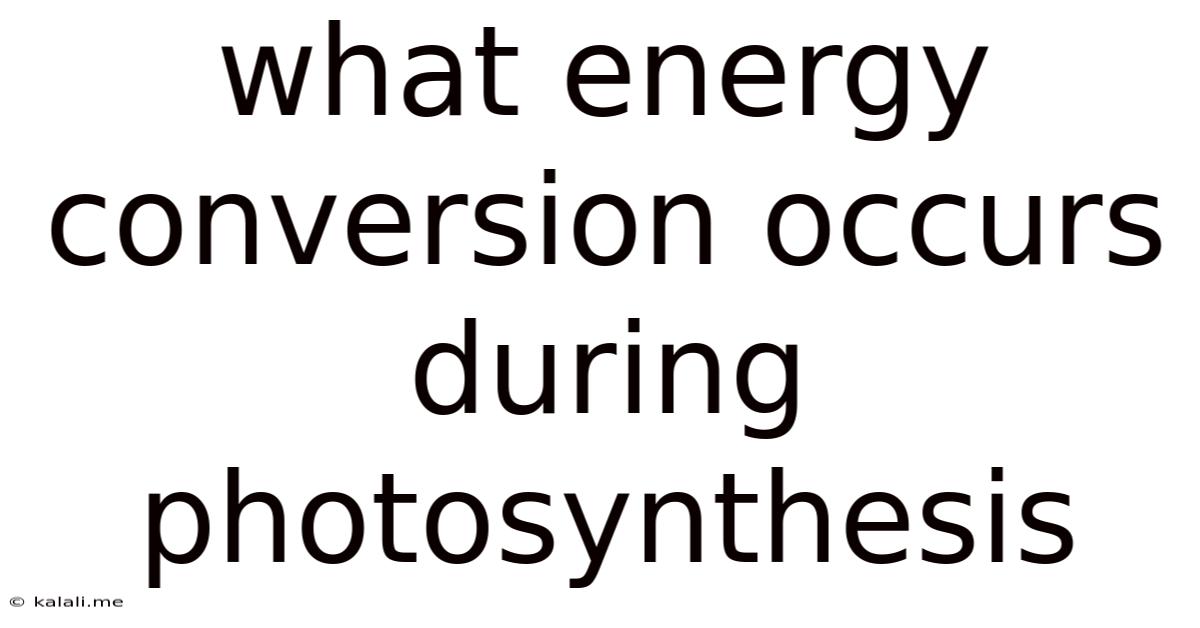What Energy Conversion Occurs During Photosynthesis
Kalali
Jun 11, 2025 · 3 min read

Table of Contents
What Energy Conversion Occurs During Photosynthesis?
Photosynthesis is the remarkable process by which green plants and some other organisms use sunlight to synthesize foods with the release of oxygen. But what's actually happening at an energy level? This article will delve into the fascinating energy conversions that occur during this vital process, explaining how light energy is transformed into the chemical energy stored in glucose. Understanding this fundamental biological process is key to appreciating the role of plants in sustaining life on Earth.
The Core Process: Light Energy to Chemical Energy
At its heart, photosynthesis is all about converting light energy into chemical energy. This conversion happens in two main stages: the light-dependent reactions and the light-independent reactions (also known as the Calvin cycle).
Light-Dependent Reactions: Capturing Sunlight's Power
This stage takes place in the thylakoid membranes within chloroplasts. The key players are chlorophyll and other photosynthetic pigments which absorb light energy from the sun. This absorbed light energy excites electrons in the chlorophyll molecules, initiating a chain of events:
- Excitation of Electrons: Light energy boosts electrons to a higher energy level.
- Electron Transport Chain: These high-energy electrons are passed along an electron transport chain, a series of protein complexes embedded in the thylakoid membrane. As electrons move down the chain, energy is released.
- ATP Synthesis: This released energy is used to pump protons (H⁺ ions) across the thylakoid membrane, creating a proton gradient. This gradient drives the synthesis of ATP (adenosine triphosphate), the cell's primary energy currency.
- NADPH Production: At the end of the electron transport chain, electrons are accepted by NADP⁺, reducing it to NADPH. NADPH is another crucial energy-carrying molecule used in the next stage.
- Water Splitting (Photolysis): To replace the electrons lost by chlorophyll, water molecules are split (photolysis), releasing electrons, protons (H⁺), and oxygen (O₂). This is the source of the oxygen we breathe.
Light-Independent Reactions (Calvin Cycle): Building Sugars
This stage takes place in the stroma, the fluid-filled space surrounding the thylakoids. Here, the chemical energy stored in ATP and NADPH from the light-dependent reactions is used to convert carbon dioxide (CO₂) into glucose. This is a cyclical process involving several enzymatic reactions:
- Carbon Fixation: CO₂ is incorporated into an existing five-carbon molecule (RuBP) with the help of the enzyme RuBisCO.
- Reduction: ATP and NADPH provide the energy and reducing power to convert the resulting six-carbon molecule into a three-carbon sugar (G3P).
- Regeneration: Some G3P molecules are used to regenerate RuBP, keeping the cycle going.
- Glucose Synthesis: Other G3P molecules are combined to form glucose (C₆H₁₂O₆), a six-carbon sugar that stores the chemical energy captured from sunlight. Glucose then serves as the building block for other organic molecules like starch and cellulose.
In Summary: The Energy Transformation
The overall energy conversion in photosynthesis can be summarized as follows:
Light energy + H₂O + CO₂ → Chemical energy (glucose) + O₂
The light energy absorbed by chlorophyll is converted into the chemical energy stored in the bonds of glucose molecules. This chemical energy fuels all the metabolic processes of the plant and ultimately serves as the foundation of most food chains on Earth. This incredible energy transformation is essential for life as we know it. The process is remarkably efficient, although the exact efficiency varies depending on several factors, including light intensity, temperature, and the availability of water and carbon dioxide. Further research continues to unravel the intricate details of this fundamental biological process.
Latest Posts
Latest Posts
-
How Long Does It Take To Walk Five Miles
Jul 01, 2025
-
How Many Ounces Is A Pint Of Blueberries
Jul 01, 2025
-
How Many Dimes Are In 5 Dollars
Jul 01, 2025
-
How Many Cups Is 12 Oz Of Chocolate Chips
Jul 01, 2025
-
How Do You Beat Level 7 On Bloxorz
Jul 01, 2025
Related Post
Thank you for visiting our website which covers about What Energy Conversion Occurs During Photosynthesis . We hope the information provided has been useful to you. Feel free to contact us if you have any questions or need further assistance. See you next time and don't miss to bookmark.